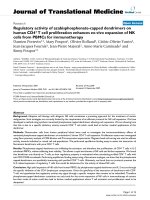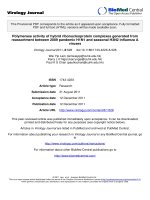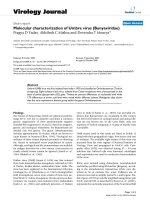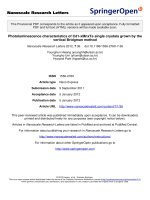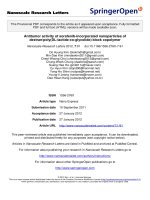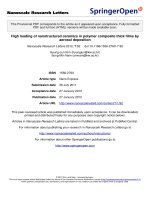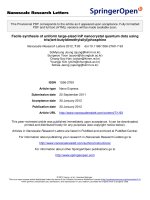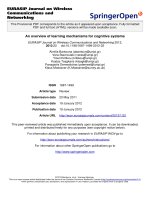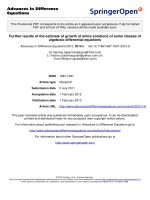Báo cáo toán học: " Antitumor activity of sorafenib-incorporated nanoparticles of dextran/poly(DL-lactide-co-glycolide) block copolymer" pdf
Bạn đang xem bản rút gọn của tài liệu. Xem và tải ngay bản đầy đủ của tài liệu tại đây (2.83 MB, 14 trang )
This Provisional PDF corresponds to the article as it appeared upon acceptance. Fully formatted
PDF and full text (HTML) versions will be made available soon.
Antitumor activity of sorafenib-incorporated nanoparticles of
dextran/poly(DL-lactide-co-glycolide) block copolymer
Nanoscale Research Letters 2012, 7:91 doi:10.1186/1556-276X-7-91
Do Hyung Kim ()
Min-Dae Kim ()
Cheol-Woong Choi ()
Chung-Wook Chung ()
Sueng Hee Ha ()
Cy Hyun Kim ()
Yong-Ho Shim ()
Young-Il Jeong ()
Dae Hwan Kang ()
ISSN 1556-276X
Article type Nano Express
Submission date 15 September 2011
Acceptance date 27 January 2012
Publication date 27 January 2012
Article URL />This peer-reviewed article was published immediately upon acceptance. It can be downloaded,
printed and distributed freely for any purposes (see copyright notice below).
Articles in Nanoscale Research Letters are listed in PubMed and archived at PubMed Central.
For information about publishing your research in Nanoscale Research Letters go to
/>For information about other SpringerOpen publications go to
Nanoscale Research Letters
© 2012 Kim et al. ; licensee Springer.
This is an open access article distributed under the terms of the Creative Commons Attribution License ( />which permits unrestricted use, distribution, and reproduction in any medium, provided the original work is properly cited.
1
Antitumor activity of sorafenib-incorporated nanoparticles of
dextran/poly(DL-lactide-co-glycolide) block copolymer
Do Hyung Kim
†1,2
, Min-Dae Kim
†3
, Cheol-Woong Choi
3
, Chung-Wook Chung
1
, Seung Hee
Ha
1
, Cy Hyun Kim
1,2
, Yong-Ho Shim
1
, Young-Il Jeong*
1
, and Dae Hwan Kang*
1,2
1
National Research & Development Center for Hepatobiliary Cancer, Research Institute for
Convergence of Biomedical Science and Technology, Pusan National University Yangsan
Hospital, Beomeo-ri, Mulgeum-eup, Yangsan, 626-770, Republic of Korea
2
School of Medicine, Pusan National University, Yangsan, 626-770, Republic of Korea
3
Department of Internal Medicine, Medical Research Institute, Pusan National University
School of Medicine and Medical Research Institute, Yangsan, 626-770, Republic of Korea
†
Contributed equally
*Corresponding authors:
;
†
Contributed equally
Email addresses:
DHK:
M-DK:
C-WC:
C-WC:
SHH:
CHK:
Y-HS:
Y-IJ:
DHK:
Abstract
Sorafenib-incoporated nanoparticles were prepared using a block copolymer that is composed
of dextran and poly(DL-lactide-co-glycolide) [DexbLG] for antitumor drug delivery.
Sorafenib-incorporated nanoparticles were prepared by a nanoprecipitation-dialysis method.
Sorafenib-incorporated DexbLG nanoparticles were uniformly distributed in an aqueous
solution regardless of the content of sorafenib. Transmission electron microscopy of the
sorafenib-incorporated DexbLG nanoparticles revealed a spherical shape with a diameter <
300 nm. Sorafenib-incorporated DexbLG nanoparticles at a polymer/drug weight ratio of
40:5 showed a relatively uniform size and morphology. Higher initial drug feeding was
associated with increased drug content in nanoparticles and in nanoparticle size. A drug
release study revealed a decreased drug release rate with increasing drug content. In an in
vitro anti-proliferation assay using human cholangiocarcinoma cells, sorafenib-incorporated
2
DexbLG nanoparticles showed a similar antitumor activity as sorafenib. Sorafenib-
incorporated DexbLG nanoparticles are promising candidates as vehicles for antitumor drug
targeting.
Keywords: sorafenib; polymeric micelle; dextran; poly(DL-lactide-co-glycolide).
Introduction
Nanoparticles have been extensively investigated as a means of specifically targeting drugs to
a desirable site of action [1]. Notably, nanoparticles having a hydrophobic inner core and
hydrophilic outer shell have received great attention due to their superior properties in drug
delivery [2-6]. They are regarded to be ideal vehicles for antitumor drug delivery because
their hydrophobic inner core is an appropriate reservoir for hydrophobic anticancer drugs and
because their hydrophilic outer shell facilitates avoidance of the reticuloendothelial system,
long blood circulation, and the improvement of enhanced permeation and retention [EPR]
effect in tumor tissue [6].
Cholangiocarcinoma [CC], a malignant tumor arising from the biliary tract, has a high
mortality rate. Even though surgical resection is regarded as a curative method, most of
patients diagnosed with a latent CC state are not considered for surgical resection [7].
Furthermore, conventional radiation or chemotherapeutic treatment is known to have limited
advantages [7]. Therefore, novel treatment option is required to enhance therapeutic efficacy
of CC.
Sorafenib inhibits tumor cell proliferation and vascularization by the activation of the
receptor for tyrosine kinase signaling in the Ras/Raf/Mek/Erk cascade pathway [8]. Sorafenib
is an effective chemotherapeutic agent against various tumor types including CC [9] and
inhibits proliferation, angiogenesis, and invasion of tumor cells [9, 10]. However, poor
aqueous solubility and undesirable side effects limit the clinical application and local
treatment of sorafenib. These side effects might be overcome by use of nanoparticles for
tumor delivery and controlled release of sorafenib [11, 12].
In this study, we prepared sorafenib-incorporated DexbLG nanoparticles as an antitumor drug
delivery system. The properties of sorafenib-incorporated DexbLG nanoparticles were
studied in terms of core-shell structure, particle size, morphology, and drug release rate.
Antitumor activity of sorafenib-incorporated DexbLG nanoparticles was tested using human
cholangiocarcinoma [HuCC-T1] cells.
Experimental details
Materials
Dextran from Leuconostoc spp. (average molecular weight [MW] approximately 6,000),
hexamethylene diamine [HMDA], N,N-dicylohexylcarbodiimide [DCC], and N-
hydroxysuccimide [NHS] were purchased from Sigma-Aldrich (St. Louis, MO, USA).
Sorafenib was purchased from LC Laboratories (Woburn, MA, USA). Spectra/Por
TM
dialysis
membranes (MW cutoff [MWCO] = 2,000 g/mol and 8,000 g/mol) were purchased from
Spectrum Labs (Rancho Dominguez, CA, USA). Poly(DL-lactic acid-co-glycolic acid)
(PLGA-5005, MW = 5,000 g/mol) were purchased from Wako Pure Chemicals (Osaka,
3
Japan).
Synthesis of DexbLG copolymer
DexbLG copolymer was synthesized as reported previously [13]. Aminated dextran was
prepared as follows. Dextran (180 mg) dissolved in dimethylsulfoxide [DMSO] was mixed
with sodium cyanoborohydride and stirred for 24 h. After that, 10 equivalents of HMDA were
added and stirred for 24 h at room temperature. The resulting aminated dextran was obtained
by dialysis against deionized water and was lyophilized. N-hydroxysuccimide PLGA [PLGA-
NHS] was prepared by reaction with DCC and NHS. DexbLG copolymer was prepared by
dissolving 120 mg of aminated dextran and 100 mg of PLGA-NHS in DMSO and undergoing
reaction for 2 days. Reactants were dialyzed to remove unreacted dextran (MWCO of dialysis
membrane = 8,000 g/mol), and the product was lyophilized. The resulting white powder was
dissolved in chloroform to remove unreacted PLGA. Yield of the final product was about
89% (w/w).
Preparation of sorafenib-incorporated DexbLG nanoparticles
The sorafenib-incorporated DexbLG nanoparticles were prepared by the nanoprecipitation-
dialysis method as follows. DexbLG copolymer dissolved in 3 ml of DMSO was mixed with
sorafenib in 2 ml of DMSO. This solution was added dropwise to 15 ml of deionized water
for over 10 min to form nanoparticles. The solvent was removed by dialysis against deionized
water for 1 day. Empty nanoparticles of DexbLG copolymer were prepared by the same
procedure, omitting sorafenib. To evaluate the drug contents and loading efficiency, 5 mg of
sorafenib-incorporated nanoparticles were distributed into the mobile phase
(acetonitrile/methanol/1% acetic acid in a ratio of 35:38:27) and stirred overnight. Drug
concentration was determined with high-performance liquid chromatography [HPLC]. The
drug content (in percent) was calculated using the following equations:
Drug weight in the nanoparticles
Drug content = 100
Weight of the nanoparticles
×
and
Residual drug in the nanoparticles
Loading efficiency = 100
Initial feeding amount of drugs
× .
Analysis of nanoparticles
The characterization of nanoparticles was performed in DMSO-d
6
or D
2
O using 500 MHz
1
H
nuclear magnetic resonance [NMR] spectroscopy (500 MHz superconducting FT-NMR
spectrometer; Varian Unity-Inova 500; Agilent Technologies, Foster City, CA, USA). The
morphology of nanoparticles was observed by transmission electron microscopy [TEM] using
a JEM-2000 FX II microscope (JEOL, Tokyo, Japan). One drop of nanoparticle solution
containing phosphotungstic acid (0.05% w/w) was placed onto a carbon film coated on a
copper grid for TEM. Observation was done at an accelerating voltage of 80 kV. The particle
size and zeta potential were measured by the Nano-ZS apparatus (Malvern Instruments,
Malvern, UK). A sample solution prepared by dialysis was used to determine the particle size.
Drug release study in vitro
The release experiment was carried out in vitro. A sample solution prepared by dialysis was
used directly. This solution was introduced into the dialysis membrane. Next, the dialysis
membrane was placed in a 200-ml bottle with 100 ml of phosphate buffered saline [PBS]
4
containing 1% (v/v) Tween 80 [PBST]. This bottle was placed in a shaking incubator with a
stirring speed of 100 rpm at a temperature of 37°C. At specific times, the PBST was sampled
for analysis of drug concentration. After each sampling, the entire volume of PBST was
replaced with fresh PBST to prevent drug saturation. The concentration of the released
sorafenib was determined by HPLC.
HPLC analysis
The Flexar HPLC system (PerkinElmer, Waltham, MA, USA) was equipped with a Solvent
Manager 5-CH degasser, an autosampler, a quaternary LC pump, a column oven, and a UV-
visible detector. Chromatography was performed on a guard column (SecurityGuard
®
Guard
Cartridge Kit; Phenomenex, Torrance, CA, USA) and on a C18 column (Brownlee C18
®
, 5
µm, 150 × 4.6; PerkinElmer) at 37°C. Sorafenib was eluted isocratically with mobile phase
(acetonitrile/methanol/1% acetic acid at a ratio of 35:38:27) at a flow rate of 1 ml/min and
monitored at 254 nm. The chromatograms were recorded and integrated with the Chromera
2.1 system software (PerkinElmer).
Cell cytotoxicity test in vitro
HuCC-T1 cells maintained in RPMI 1640 (10% fetal bovine serum, 5% CO
2
at 37°C) were
used to evaluate the antitumor activity of sorafenib-incorporated nanoparticles. Viability of
tumor cells was evaluated by a 3-(4,5-dimethylthiazol-2-yl)-2,5-diphenyltetrazolium bromide
[MTT]-based cell proliferation assay. HuCC-T1 cells were seeded at a density of 2 × 10
3
cells/well in 96-well plates with 100 µl of medium before addition of polymeric micelles.
Next, free sorafenib, sorafenib-incorporated polymeric micelles, or empty polymeric micelles
were added to 96-well plates at 100 µl. Controls were treated with 0.1% (v/v) of DMSO.
Cells were incubated for 48 h, and cell viability was then measured in triplicate using an
established MTT assay protocol.
Results and discussion
Characterization of sorafenib-incorporated DexbLG nanoparticles
Dextran is an appropriate macromolecule for block copolymerization because it has one
reductive end. DexbLG copolymer was synthesized by the coupling of aminated dextran and
PLGA as described previously (Figure 1b) [13]. In the block copolymer, dextran acts as a
hydrophilic domain and PLGA acts as a biodegradable hydrophobic domain.
1
H NMR
revealed the theoretical [MW
T
] and experimental [MW
E
] MWs of DexbLG copolymer as
10,100 and 9,580 g/mol, respectively, while the MW of PLGA was 4,920 g/mol (M
w
) and
4,780 g/mol (M
n
) in gel permeation chromatography (data not shown). Because the DexbLG
copolymer is amphiphilic, it may form core-shell type nanoparticles in an aqueous
environment [2, 5, 13]. In this configuration, dextran comprises the hydrophilic outer shell,
while PLGA comprises the hydrophobic core that is the actual reservoir of sorafenib.
Sorafenib (Figure 1a) is a relatively novel class of angiogenesis inhibitor, which was selected
as an anticancer drug due to its poor aqueous solubility. Nanoparticles are regarded as an
ideal candidate for these kinds of drugs because the abundant microvascular structure of the
tumor tissue is a useful target for nanoparticulate drug delivery system via the EPR effect.
Nanoparticles of DexbLG copolymer were prepared by nanoprecipitation-dialysis method
5
[13]. Nanoprecipitation-dialysis method was superior over direct dialysis in minimizing
particle size of nanoparticles (data not shown) [14]. Empty nanoparticles of DexbLG had a
spherical shape with a diameter < 100 nm (Figure 2a). As summarized in Table 1, their
average particle size was 46 nm. Sorafenib-loaded DexbLG nanoparticles were increased in
size, with their size being related to the quantity of drug loaded (Figure 2b,d). Among them,
nanoparticles with a polymer/dry weight ratio of 40:2 and 40:5 showed a relatively uniform
size distribution in contrast to 40:7 nanoparticles. Particle size analysis of sorafenib-
incorporated DexbLG nanoparticles also showed an increased average particle size according
to the contents of drug in the nanoparticles (Table 1). Zeta potential was not significantly
changed according to drug incorporation. Drug contents were increased according to the
feeding amount of drug (Table 1). Drug loading efficiency was lowest at 40:2, while 40:5 and
40:7 nanoparticles showed a loading efficiency > 35%.
To investigate the core-shell structure of nanoparticles and drug incorporation,
1
H NMR was
adapted to measure nanoparticles in DMSO-d
6
or D
2
O (Figure 3). Sorafenib displayed
intrinsic peaks in its
1
H NMR spectrum between 0.5 and 9.5 ppm (Figure 3a). When
sorafenib-incorporated nanoparticles were reconstituted in D
2
O, only dextran peaks between
2.5 and 5.0 ppm were observed, while specific sorafenib and PLGA peaks at 1.45, 3.35, and
4.9 ppm disappeared (Figure 3c). However, all the peaks of sorafenib, dextran domain, and
PLGA domain were apparent when nanoparticles were dissolved in DMSO (Figure 3b).
These results indicated that sorafenib was successfully entrapped into the PLGA core of the
nanoparticles and that the dextran domain constituted the hydrophilic outer shell.
Sorafenib release study was performed in vitro. Sorafenib release rate from 40:5
nanoparticles into PBST was significantly low, with <10% of the total incorporated drug
being released over 2 weeks (Figure 4). Therefore, PBST was used to maintain a sink
condition in subsequent experiments. The sorafenib release rate changed according to the
drug contents; increased drug incorporation produces slower release rates (Figure 4b).
Notably, an initial burst of release from 40:2 nanoparticles was observed until 6 h, followed
by a sustained release of sorafenib for 2 weeks. Unexpectedly, 40:5 and 40:7 nanoparticles
showed a very low drug release for 2 weeks. This phenomenon might be due to the
hydrophobic interaction at higher drug contents in the core of nanoparticles [2, 13]. At higher
drug contents, the hydrophobic drug might crystallize in the solid core of the nanoparticles,
which would markedly hinder drug released [2]. However, when the absolute amount of
released drug was compared, 40:2 and 40:5 nanoparticles showed an almost equal amount of
drug release until 96 h (Figure 4a).
In vitro cell cytotoxicity
Antitumor activity of sorafenib-incorporated DexbLG nanoparticles was tested using HuCC-
T1 cells. Sorafenib itself showed a dose-dependent antiproliferative effect against tumor cells
that was almost the same as that produced by sorafenib-incorporated DexbLG nanoparticles,
while empty DexbLG nanoparticles did not significantly inhibit cell viability (Figure 5).
These results indicate that DexbLG copolymer has no significant cytotoxicity against tumor
cells, and sorafenib-incorporated DexbLG has at least similar antitumor activity in vitro.
Nanoparticles or nanomatrix was known to improve bioavailability [11] and antitumor
activity in vivo [12] with a decreased hemolysis or myelosuppression effect. Our results
demonstrate that DexbLG nanoparticles are appropriate vehicles for sorafenib transport and
release and that the nanoparticles are superior candidates for antitumor drug delivery.
6
Conclusion
In this study, we prepared sorafenib-incorporated nanoparticles by nanoprecipitation-dialysis
method. Sorafenib-incorporated DexbLG nanoparticles adopt a spherical shape with a size <
300 nm. The higher the initial drug feeding, the higher is the quality of incorporated sorafenib.
The size of the nanoparticles was increased according to the amount of sorafenib. Increasing
quantity of incorporated sorafenib decreases the release rate of the drug. Sorafenib-
incorporated DexbLG nanoparticles have a similar antitumor activity against tumor cells in
vitro compared to sorafenib itself. The collective results indicate the promise of sorafenib-
incorporated DexbLG nanoparticles as vehicles for antitumor drug targeting.
Competing interests
The authors declare that they have no competing interests.
Authors' contributions
DHK carried out the preparation of nanoparticles and drafted the manuscript. M-DK carried
out the drug release studies. C-WC participated in the NMR analysis. C-WC participated in
the analysis of drug contents and particle size. SHH participated in the observation of
electron microscope. CHK participated in the cell viability assay. Y-HS designed the
chemical structure of polymer. Y-IJ participated in the design of the study and coordination.
DHK conceived the study and participated in its design and coordination. All authors read
and approved the final manuscript.
Acknowledgement
This study was supported by a grant of the Korean Healthcare Technology R&D Project,
Ministry of Health and Welfare, Republic of Korea (project number A091047).
References
1. Allemann E, Gurny R, Doelker E: Drug loaded poly(lactic acid) nanoparticles produced
by a reversible salting-out process: purification of an injected dosage form. Eur J Pharm
Biopharm 1993, 39:173-191.
2. Gref R, Minamitake Y, Peracchia MT, Trubetskoy V, Torchilin V, Langer R:
Biodegradable long-circulating polymeric nanospheres. Science 1994, 263:1600-1603.
3. La SB, Okano T, Kataoka K: Preparation and characterization of the micelle-forming
polymeric drug indomethacin-incorporated poly(ethylene oxide)-poly(beta-benzyl L-
aspartate) block copolymer micelles. J Pharm Sci 1996, 85:85-90.
4. Kwon GS, Naito M, Yokoyama M, Okano T, Sakurai Y, Kataoka K: Physical entrapment
of adriamycin in AB block copolymer micelles. Pharm Res 1995, 12:192-195.
5. Kwon GS, Naito M, Yokoyama M: Micelles based on AB block copolymers of
poly(ethylene oxide) and poly(β
ββ
β-benzyl L-aspartate). Langmuir 1993, 9:945-949.
7
6. Kwon GS, Yokoyama M, Okano T, Sakurai Y, Kataoka K: Biodistribution of micelle-
forming polymer-drug conjugates. Pharm Res 1993, 10:970-974.
7. Seehofer D, Kamphues C, Neuhaus P: Management of bile duct tumors. Expert
OpinPharmacother 2008, 9:2843-2856.
8. Wilhelm SM, Adnane L, Newell P, Villanueva A, Llovet JM, Lynch M: Preclinical
overview of sorafenib, a multikinase inhibitor that targets both Raf and VEGF and
PDGF receptor tyrosine kinase signaling. Mol Cancer Ther 2008, 7:3129-3140.
9. Liu L, Cao Y, Chen C, Zhang X, McNabola A, Wilkie D, Wilhelm S, Lynch M, Carter C:
Sorafenib blocks the RAF/MEK/ERK pathway, inhibits tumor angiogenesis, and
induces tumor cell apoptosis in hepatocellular carcinoma model PLC/PRF/5. Cancer Res
2006, 66:11851-11858.
10. Qun W, Tao Y: Effective treatment of advanced cholangiocarcinoma by hepatic
arterial infusion chemotherapy combination with sorafenib: one case report from China.
Hepatogastroenterology 2010, 57:426-429.
11. Wang XQ, Fan JM, Liu YO, Zhao B, Jia ZR: Zhang Q: Bioavailability and
pharmacokinetics of sorafenib suspension, nanoparticles and nanomatrix for oral
administration to rat. Int J Pharm 2011, 419:339-346.
12. Zhang JY, He B, Qu W, Cui Z, Wang YB, Zhang H, Wang JC, Zhang Q: Preparation of
the albumin nanoparticle system loaded with both paclitaxel and sorafenib and its
evaluation in vitro and in vivo. J Microencapsul 2011, 28:528-536.
13. Jeong YI, Kim DH, Chung CW, Yoo JJ, Choi KH, Kim CH, Ha SH, Kang DH:
Doxorubicin-incorporated polymeric micelles composed of dextran-b-poly(DL-lactide-
co-glycolide) copolymer. Int J Nanomedicine 2011, 6:1415-1427.
14. Jeong YI, Kim DG, Jang MK, Nah JW, Kim YB: All-trans retinoic acid release from
surfactant-free nanoparticles of poly(DL-lactide-co-glycolide). Macromol Res 2008,
16:717-724.
Figure 1. Chemical structure of sorafenib (a) and DexbLG copolymer (b).
Figure 2. TEM images of sorafenib-incorporated nanoparticles. Polymer:drug empty
nanoparticle (a), 40:2 (b), 40:5 (c), 40:7 (d) nanoparticles.
Figure 3.
1
H NMR spectra. Sorafenib in DMSO (a); SORA-NP, sorafenib-incorporated
nanoparticles in DMSO (b); and SORA-NP in D
2
O (c). The box shows typical peaks of
sorafenib (a), and the arrow shows typical peaks of PLGA (b).
Figure 4. Sorafenib release from the DexbLG nanoparticles. Time course of the absolute
amount of released sorafenib (a) and total percentage of released sorafenib from DexbLG
nanoparticles (b). Drug release experiment of 40:2 (filled circle), 40:5 (empty circle), and
8
40:7 (inverted filled triangle) was performed with PBST, and 40:5 (PBS; empty triangle) was
performed with PBS only.
Figure 5. Growth inhibition of HuCC-T1 cells by treatment of sorafenib-incorporated
DexbLG nanoparticles. Two thousand cells were exposed to sorafenib, empty nanoparticles,
and sorafenib-incorporated nanoparticles for 48 h.
Table 1. Characterization of sorafenib-incorporated nanoparticles
Drug contents (%, w/w)
Polymer/drug
(mg/mg)
Theoretical Experimental
Loading
efficiency
(%, w/w)
Particle size
(nm)
Zeta potential
(mV)
40:0 - - - 46 ± 1.12 −36.4 ± 3.1
40:2 4.76 1.23 25.84 63 ± 0.58 −35.5 ± 2.2
40:5 11.11 4.36 39.24 133 ± 0.58 −36.0 ± 1.1
40:7 14.89 5.26 35.33 181 ± 1.15 −35.8 ± 0.9
